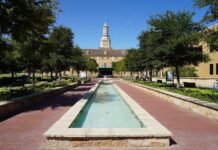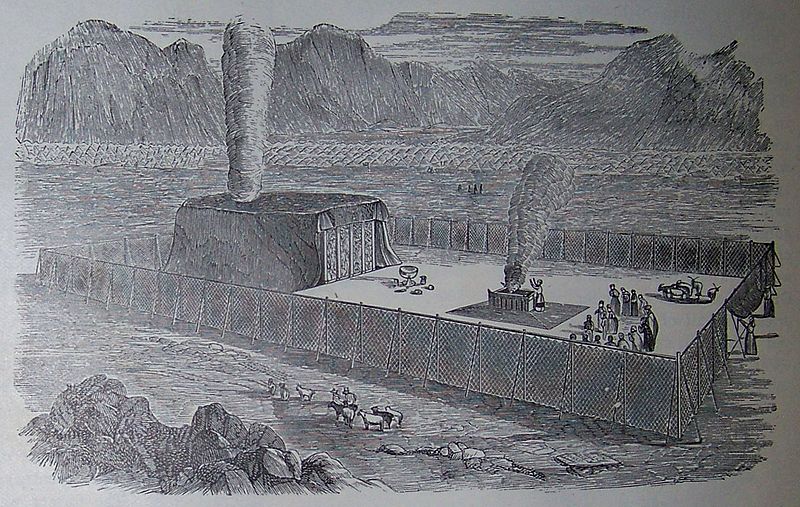In the word “Terumah” (“תרומה”) we find a hint of things to come within a certain time period. The word Terumah conceals the word Torah (“תורה”) and the letter “Mem” (“מ”) which is 40 in Gematria, to teach us that in forty days Bnei-Yisrael will be receiving the Torah. It also refers to the 40 years in the desert Beni Yisrael will be punishment due to the spies sin, learning the Torah.
HaShem spoke to Moshe and instructed Bnei-Yisrael to “take” a contribution and dedicated it to Him and for the building of the Mishkan (“משכן”) the Tabernacle. The word “Terumah” means contribution and word the Torah uses the word “take”, rather than “give” as giving Tzedakah. This comes to teach us that when one “takes” such action to give and contribute, he/she takes this Mitzvah with him/her forever. As we know all that is given to us is by HaShem, and we cannot take it with us after the physical death to the next world. The only thing we can take with us is our Mitzvot and good deeds. In the same verse HaShem says “take for me” (“ויקחו לי”); the numerical value of the word “Li” (“לי”) is 40, to teach us that we need to give one-fortieth of what we own as contribution (less fortunate people can give one-fiftieth or one-sixtieth). The merit of such giving helps the Neshamah (our soul) forever. We are obligated to give a tenth of our earnings as Tzedakah. Another reason is to teach us that immediately after forty days of waiting to receive the Torah we must build the Mishkan to place the Torah in it.
This Parasha is always read before Purim (on a regular 12-month year), as we are obligated to remind ourselves about the Shekalim (“שְׁקָלִים“) at the beginning of the month of Adar (it is worth mentioning that this is the only Talmud Yerushalmi Masecheta that made it into the Talmud Bavli). The Mitzvah is to announce about the “Shekalim, fourth tractate in the order of Mo’ed, which deals with the annual half-shekel tax collected for the maintenance of the Temple and its services. The month of A’dar brings us Purim and Simcha (happiness). Rabbi Shemuel Bar Shilat (“שמואל בר שילת”) wrote in the Talmud (Bavli, Ta’anit) the famous verses “MiShenichnas A’adar Marbim Besimcha” (“משנכנס אדר מרבים בשמחה”) and “MiShenichnas A’av Mameitin Besimcha“ (“משנכנס אב ממעטין בשמחה”). This Rabbi was none other the Haman’s grandson who made Teshuvah together with another grandson, and lived in Bnei-Berak.
By asking “take to me” Terumah HaShem wants such donations from people who give it willingly. The word the Torah uses the words “Yidvenu Libo” (“יִדְּבֶנּוּ לִבּוֹ”) giving from the heart. The words “take for me” teach us that one should take quietly such offerings and keep it privately to himself. It is a greater Mitzvah to do it in secret and not to advertise such giving, as it is a higher form of Chessed. Although sometimes its good to advertise in order to entice others to donate. The word Chessed (“חסד” – kindness) has two hidden words in it, “Sod” (“סד“ – secret) and “Chas” (“חס“ – mercy). When we do an act of Chessed it should be out of kindness and in secret. The name of HaShem (“יהוה”) has the secret to giving Terumah and Tzedakah.
The letters are arranged in such order:
- “י” – “Yud” – is equal to 10 as the tenth “Maaser” (“מעשר“) we give the Kohen as Terumah
- “ה” – “Hei” – as the five fingers of the palm-hand that gives the Terumah
- “ו” – “Vov” – as the arm-hand that receives the Terumah
- “ה” – “Hei” – as the five fingers of the palm-hand that receives the Terumah
HaShem told Moshe that the contributions for the Mishkan should be given voluntarily. The Mishkan was the temporary, portable Beit-HaMikdash while Bnei-Yisrael traveled in the Sinai desert. HaShem provided a list of materials and offerings to help with the construction of the Mishkan. The first two items were gold and silver, using some the gold and silver Bnei-Yisrael took from Egypt for a holy use. We learn that there were fifteen items that needed for the Mishkan:
זָהָב וָכֶסֶף, וּנְחֹשֶׁת. וּתְכֵלֶת וְאַרְגָּמָן וְתוֹלַעַת שָׁנִי, וְשֵׁשׁ וְעִזִּים. וְעֹרֹת אֵילִם מְאָדָּמִים וְעֹרֹת תְּחָשִׁים, וַעֲצֵי שִׁטִּים. שֶׁמֶן, לַמָּאֹר; בְּשָׂמִים לְשֶׁמֶן הַמִּשְׁחָה, וְלִקְטֹרֶת הַסַּמִּים. אַבְנֵי-שֹׁהַם, וְאַבְנֵי מִלֻּאִים
The number fifteen alludes to the fifteenth day of the month when the moon is full. The Sages teach us that when the moon is full the Shechinah (holiness) is in full force. It is interesting to note that most of our holidays fall on the fifteenth day of the month; for example Purim, Tu BeShe’vat, Pesach, and Sukkoth.
This Parasha teaches us all about the thirty-nine “Melachot” (“מלאכות“ – crafts, types of work) that we are not allowed to do on Shabbat. The thirty-nine forbidden “Melachot” are based on the “Melachot” that were performed in the building of the Mishkan.
We learn that when a farmer is ready to harvest his field he must first give Terumah to the Kohen. The Torah writes that each person shall give as “his heart desires” and not set a minimum or maximum. The word the Torah uses is “Yidveno” (“ידבנו“), which has the word “Nedava” “נדבה“ – from the root word “נדב“ Nadav, another word for Tzedakah (“צדקה”) meaning what one sees fit to give by his/her own choosing. The word “Yidveno” has a secret meaning as it has two words in it: the word “Banu” (“בנו” – within us) and the letters “Y-D” (“יד” – HaShem’s acronym), alluding to people who truly have faith in HaShem within them.
The following terms in the Torah all have the same numerical value of 821 describing such giving.
Yekechu Li Terumah יקחו לי תרומה = 821
Yafrishu Li Teruma יפרישו ממון וזה נדבה = 821
Nedava Leshem Shamaim נדבה לשם שמים = 821
Hamamon LaKadosh Baruch Hu הממון לקדוש ברוך הוא = 821
There is an amazing connection between the three parts of this giving; HaShem, the Terumah, and the Kohen. The reason we learn about the connection between giving Terumah and HaShem, is related to the laws of “Isha Sota” (“אישה סוטה”), a woman whose husband suspects her of being unfaithful. In the event of a husband who suspected that his wife of being unfaithful he took her to the Kohen in the Beit-HaMikdash, who starts a special process. The Kohen was to take this portion of the Torah from that discusses this event, mix it with holy water, and give it to the woman to drink. HaShem was “willing” to have His name erased in such water, in order to keep “Shalom Bayit” (peace at home). Immediately following this portion of “Isah Sota”, in which HaShem’s name is included, the Torah discusses the giving of gifts to the Kohen. Rashi says that when one does not allocate Terumah to the Kohen, as ordered in our Parasha, HaShem will make sure that he will be standing in front of the Kohen, with his wife, in such an embarrassing process. By giving the Terumah to the Kohen one assures that HaShem’s name will never be erased.
HaShem provided Bnei-Yisrael with a list of materials for the building of the Mishkan; one of the items was Acacia wood (“עצי שיטים”). These trees did not grow in the desert; where did Bnei-Yisrael got a hold of these trees? These are the trees Yaakov brought down to Egypt when he went to see his son Yosef. Yaakov was aware of the prophecy of the Mishkan and he brought these trees for the future. Another item that the Torah lists is the Tachash (“תחש”); this animal provided a very colorful skin and was created just for that purpose. The Tachash does not exist anymore and the Midrash tells us that when Mashiach will come the Tachash will be alive again to provide that colorful skin for the third Beit-HaMikdash. The Midrash says that this animal was too proud and acted as a “show-off”; therefore HaShem removed it from the world. HaShem also told Bnei-Yisrael about the accessories to be used by the Kohen, such as the apron (“אפוד“) and the breastplate (“חושן”).
All of Bnei-Yisrael gave Terumah immediately in order to help with the building of the Mishkan, yet the heads of the tribes (the presidents) waited to give their share only after all was collected. HaShem was upset with them and only allowed them to give a single Terumah of precious gems for the breastplate. True leaders lead by example and not lead from behind; this was a glimpse into the future sin of the heads of the tribes (the presidents).
In verse 25:8 HaShem says “They should make a sanctuary to Me, and I will dwell among them” (“וְעָשׂוּ לִי, מִקְדָּשׁ; וְשָׁכַנְתִּי, בְּתוֹכָם”); this comes to teach us that HaShem will always be with us, both in the desert in the Mishkan (וְשָׁכַנְתִּי), and in the Beit-HaMikdash (מִקְדָּשׁ). The question was asked why we needed such a sanctuary in the desert. There are a few answers to this question; one was to get Bnei-Yisrael ready for the Beit-HaMikdash in the land of Israel; another was to allow all of Bnei-Yisrael to be part of such a great Mitzvah in their lifetime, especially the generation that would not be entering Israel. The Torah writes “Ve’Asu” (“ועשו“ – they shall do), meaning they shall all take part in the building of the Mishkan, to teach us that if one cannot do or study Torah, one must support those who can do, such as Rabbis and the Yeshivah students.
Ve Asu Li Mikdash ועשו לי מקדש = 866
HaBeit-HaMikdash הבית המקדש = 866
We also learn from the word “Ve’Asu” “ועשו” (they should all do both), that we are all partners in both the Written Torah and the Oral Torah. We learn this from the word “Efod” “אפוד” (apron) which has the same numerical value of the word “Pe”“פה“ (mouth) – 85. The Oral Torah is called the Torah She-Be’al-Pe “תורה שבעל פה“ (Oral Torah). The apron (“אפוד”) is compared to Oral Torah, and the breastplate (“חושן“), is compared to the Written Torah (as all the names are written on it). Obviously a Jew cannot perform all 613 Mitzvot; there are mitzvoth that only Kohanim can perform, some of the mitzvoth can only be perform in the land of Israel, and yet, other mitzvoth can only be performed in the Beit-HaMikdash. Therefore, by giving Terumah to build the Mishkan we too are able to take part in these Mitzvot (on a side note it is interesting to notice that the first iPod is similar name and look of the“Efod” “אפוד” the IPod has the same “functions” even look the same.
We also learn this from that name Yisaschar (“יששכר”) which means HaShem gave me my reward. The name Yisaschar has two words in it: “Yesh Sachar – “יש שכר”, meaning there is a reward, since Yisaschar partnered with his brother Zevulun (“זבולון“), whose part was to work and provide for Yisaschar whose part was to study Torah and provide Mitzvot for both.
HaShem taught Moshe how to build the Mishkan, the tabernacle, by showing him the “final product”, as it says in verse 25:9, “According to all that I show you, the pattern of the tabernacle, and the pattern of all the furniture therefore, so you shall see how to make it” (“כְּכֹל, אֲשֶׁר אֲנִי מַרְאֶה אוֹתְךָ”), just as HaShem showed Moshe what half a Shekel looked like, He showed him the Menorah along with all the other vessels. HaShem wanted to teach Moshe that when we see the final outcome of a Mitzvah, we are able to be part of such a creation. We know that Radio waves exist even though we cannot see them, yet we see the end results of voice, images and even text transmission. Moshe experienced such digital imagery as HaShem “Showed him”.
HaShem wanted all of Bnei-Yisrael to participate in this Mitzvah, by donating as much as they were able to donate, and to partner with the Kohanim in building the Mishkan. By giving this Terumah we overcome our “Yetzer Hara” “יצר הרע“ (evil inclination) that always tries to convince us not to give. By donating, we do the opposite of our inclination and we achieve Chesed (“חסד“) and good deeds. The building of the Tabernacle “for HaShem” teaches us that whoever helps with such a holy task shall be paid for by the Tabernacle fund. The question is :Do the Mishkan and the Sanctuary (“מיקדש”) are one and the same? The Midrash tells us that one was for the desert; and one for Bnei-Yisrael that was set in the heavens, upper and lower realms.
HaShem provided Moshe with the full details of how to build the Ark from the Acacia wood coated with gold. We see the permanent placement of the four golden rings to the Ark, to teach us that every righteous Jew will always have four permanent sources in his life: the Written Torah, the Oral Torah, the Mitzvot, and “גמילות חסדים” Gemilut Chasadim (good deeds). The measurements of the Ark (and Shekel) were fractions of half and not whole size, to teach us that we are not whole as we must study Torah continuously and with HaShem we become whole. Just as we learn Gemara we always start on the second page (“דף ב”) and not the first page, as the Torah starts with the second letter “Beit”.
The Ark was to be coated with gold inside and outside, to teach us that we too should be good both on our inside and outside. One must always mirror what is on the outside to his inside, only then we can achieve a true golden modesty and be like the vessel as the Ark to HaShem. The two Cherubs on the Ark had baby-like images of male and female, to teach us that we should always approach the Torah as young children who are ready to learn it for the first time, as a baby learns from his mother, as the Torah is our mother and HaShem is our father. Just as the two Cherubs had their wings upwards sheltering the Ark, we too must always shelter and protect each other. These Cherubs faced each other when Bnei-Yisrael kept the Mitzvot, and when Bnei-Yisrael did not keep the Mitzvot the Cherubs turned away from each other.
HaShem promised to have His “testimony” His covenant placed in the Ark, and He will be there to meet us as it is written “ונועדתי לך שם”. HaShem will be there to teach us the Torah, and to make sure we teach our children as the Cherubs resemble young Bnei-Yisrael. The numerical value of the word “Sham” (“שם“ – there) is 340, the same as the word “Sefer” (“ספר“), the book of Torah, as HaShem met Moshe there to teach him every word of both Torahs, with its divine meaning and purpose. There are many verses in the Torah that have a numerical value of 340. For example, “והוא נסי ומנוס לי” – HaShem is my miracle and by savior, and “אני ה’ אלוהיכם ואין עוד” – I am your HaShem the only God. We are also known as “עם הספר” “Am HaSefer” people of the “book”, the Torah (good to know that this name was given by Muhammad as he admits that we received the only true Torah).


























